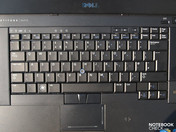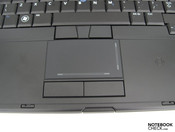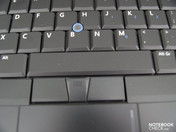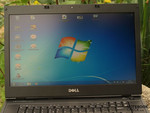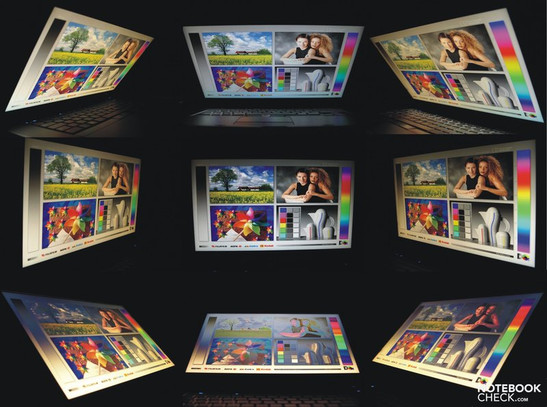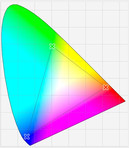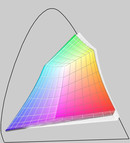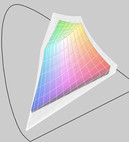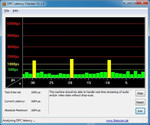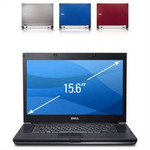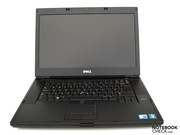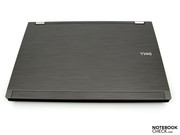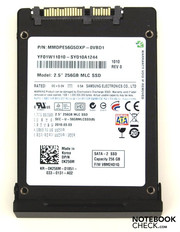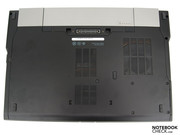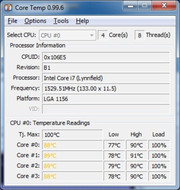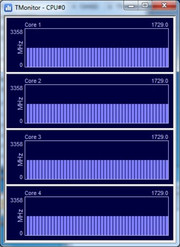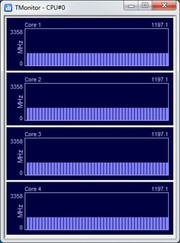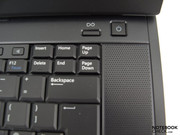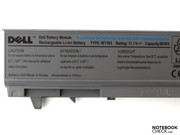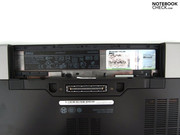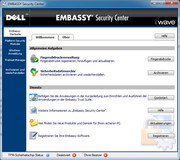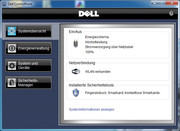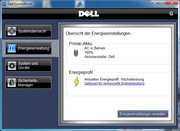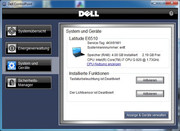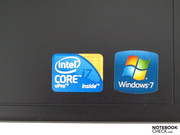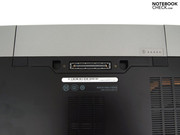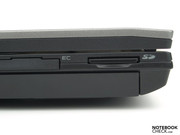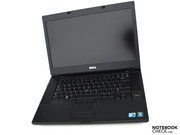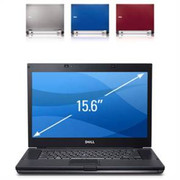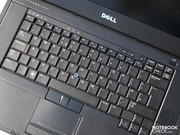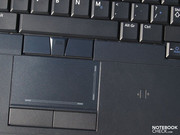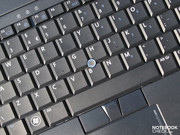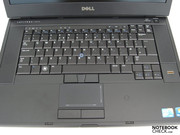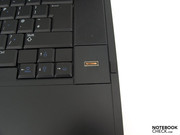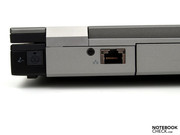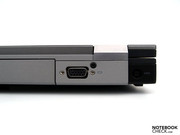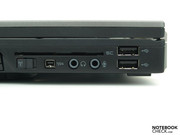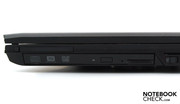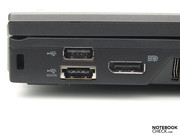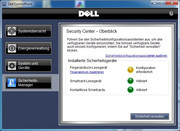Review Dell Latitude E6510 Notebook

The Latitude notebooks were developed for large and mid-sized businesses. They are therefore office all-rounders which depending on the series can be configured for different demands. As mainstream notebooks, both the E6510 (15.6") and E6410 (14.1") series should cover a broad spectrum of possible application ranges without any particular specialization.
Typical of Dell, a range of configurations are possible which we will discuss in more details in the individual sections below. But we can say this up front: Our test candidate was equipped with a high-performance Intel Core i7 820QM CPU and an discrete professional graphic card, namely a Nvidia Quadro NVS 3100M A snappy SSD with 256 GB gross capacity from Samsung was built in as the mass memory. The performance figures, battery life and emissions results are not necessarily the same for models with different hardware configurations.
Case
With its silver display lid and otherwise black components, our test model looks elegant and timeless. For a premium of 25 Euro, one can also get the E6510 with a red or black display lid.
The base unit and display lid were reinforced with metal pieces. The display lid thereby achieves an outstanding pressing and torsional rigidity. The stable display frame also hardly gives under pressure. Only the bracket on the upper edge of the display screen lid yields to even light pressure. The base unit displays good torsional rigidity. The palm rests, especially the right one, and the loudspeaker grill do, however, yield somewhat to pushing pressure. Additionally, one finds a common noticeable weakness on the Latitude E6510: In the area around the optical drive, the laptop yields noticeably to pressure both on the upper and under sides. Overall, one can be pleased with the construction. You won't find any irregular hitches in the components. Dirt particles do, however, quickly collect in small crevices, of which there are plenty in the internal space. The closed battery on the other hand does not sit fully secure in the case and wiggles somewhat.
The user is confronted with a matt-black surface. This feels pleasant and almost velvety.
The metal hinges do their work well and hold the display screen securely in the position it is set in. After changing the display screen's angle, the screen teeters only very little. Opening and closing the laptop with one hand is no problem. The opening angle is limited to around 170 degrees, which in practice should hardly pose any limitations.
Two locking hooks fixed to the screen make sure that the E6510 doesn't open unintentionally when transported. A central push button allows for easy opening of the transport locks.
In terms of mobility, it must be said that the 15.6" machine does not belong to the class of ultra-mobile machines. The measurements show, however, that the Latitude E6510 is one of the thinner notebooks. We will later see that a flat construction is not strictly advantageous. The weight of 2.5 kg, and only 0.28 kg for the thin power adapter, is on the lower end.
Connectivity
Connections
With the furnishing and configuration of the connections, both left and right-handers can be happy. We can nevertheless imagine that lefties won't be entirely pleased when using an external mouse due to the placement of the ventilation opening.
The docking port common for business laptops is found on the underside. With a compatible docking solution, the E6510 can be effortlessly integrated into the existing working environment and enhanced with ample interface offerings.
We can now take a look at the interfaces, which are placed directly on the case. Advantageously, both VGA and RJ-45 (LAN) were relegated to the backside of the E6510. Though not built into our tester, the optional RJ11 modem connection is also found on the backside. Those who aren't satisfied with an analogue picture transmission can use the digital DisplayPort, which is in the back area on the left side edge. Also there is a USB-2.0 port and a USB-eSATA combined interface. The Kensington Security Slot helps hamper theft. In the front area, the left side also offers an Express Card 34mm slot and a 6-in-1 card reader. The working area left of the notebook is thereby freed of bothersome cables.
In total, our test candidate can be hooked up to 4 USB devices. Both of the additional USB interfaces are found conveniently on the right edge in the back. Moving forward there is a SmartCard reader, both audio interfaces, FireWire (IEEE 1394) and the WiFi main switches. At the front there is a Module-Bay-Slot in which an ex works DVD drive is found. It can be easily opened, removed and put in again by pushing on the sensitive lock directly on the drive. The E6510 can also be enhanced above with PC cards.
Communication
With the Intel 82577LM Gigabit Network Connection (10Mbit), the E6510 tether can be connected to the Ethernet network. In terms of WLAN connectivity, there are several options, namely either Centrino Advanced-N 6200, Centrino Advanced-N + WiMAX6250 or the Centrino Ultimate-N 6300 built into our tester, which are all from Intel. Alternatively, it can be done with one of the two in-house WLAN modules, Dell Wireless 1501 (802.11 b/g/n 1X1) or Dell Wireless 1520 (802.11 a/g/n 2X2).
Additionally, one can have the E6510 set up with a mobile broadband modem. Also offered are the Dell Wireless 5620 Multi-mode HSPA-EVDO Mini Card (Gobi 2000) with A-GPS or the Dell Wireless 5540 Multi-mode HSPA Mini Card with A-GPS. The corresponding SIM card slot is found in the battery deck in any configuration, even on models without a broadband modem like our tester.
Data can be transferred with small mobile devices like mobile phones or PDAs via the Dell Wireless 375 Bluetooth 3.0. This module is also optional and only had for a premium, but was built into our tester.
A 3 Megapixel WebCam was integrated in the upper display screen frame. The WebCam Central from Dell allows not only to record videos but also to take individual photos. Though some adjustments can be made, especially skin color comes off rather poorly. But one is certainly well equipped for video conferences.
Software
Microsoft Windows 7 Professional 32bit was pre-installed on the E6510 we tested. The user can also choose here. Next to a downgrade to XP, other options include Windows 7 Professional or Ultimate both in 32-bit or 64-bit variations. Our tester was equipped with four gigabytes of memory (RAM). From that, only 3.18 GB of real memory are available with the 32-bit version from Windows 7 Professional. If one chooses a 64-Bit operating system, the main memory physically at hand could be much more efficiently used, not to mention a possible RAM upgrade. However, the use of a 32-bit operating system is for instance justified if no 64-bit drivers were available for the peripheral devices at hand.
Accessories
Thankfully, there are diverse data media in the box of the tester. Joining the party are a recovery DVD for the operating system, a driver and utilities DVD and the pre-installed applications as well as the Roxio Creator also on DVD. But these must apparently be ordered separately in the USA.
Security Features
Next to the Kensington Security Slot mentioned above, the E6510 also has a further security feature, namely a fingerprint reader. It has a rather unusual place inside right of the keyboard. It must be configured on first use via the Dell ControlPoint security manager. After that, password inputs can be substituted with a scan of the fingerprint. Dell also offers the option of a FIPS-Fingerprint Reader with a higher security standard on the E6510.
As for further security features, there is an integrated Trusted Platform Module (TPM) 1.2 as well as an integrated SmartCard Reader or more specifically, a "Contactless Smart Card Reader". Here the E6510 represents the same options also offered on the smaller E6410.
In terms of the offered guarantees, there is the ex works 3 year on-sight service by the next work day. Additionally, diverse value-added services (accident insurance, data recovery,...) can also be ordered.
Input Devices
Keyboard
After changing the language preferences in the setting, the US keyboard layout of our tester posed no problems, at least in terms of touch typing. Other than that, the keyboard offers namely a standard layout with a straight forward key grouping. A German layout is of course configurable. The E6510 also has a direct keyboard illumination.
The mechanical characteristics of the keys please with a relatively long stroke distance and a clear pressure point. Typing noise also stays within reason. Unfortunately, the substructure, especially in the middle area of the keyboard, yields somewhat during energetic typing.
One finds only a few additional keys on the Latitude E6510. These are only there to control the volume and mute function. Left of the on-switch is also a print button. This has no function on the operating system offered. If the machine is turned off, "Latitude On" can be started, an Instant-On operating system which should enable quick access to various data.
The broad margins right and left of the keyboard were used for the loudspeakers. But if the office machine is used a lot for numerical entries, a separate numerical keypad would be preferable.
Touchpad/Trackstick
The touchpad boasts a nice, matt surface with good gliding characteristics. Thanks to this, the mouse pointer can be precisely controlled. Depending on one's preferences, scrolling can be done either via the two visually marked scrollbars or with Multi-Touch maneuvers. The various movements can be configured in the mouse driver and turned off if necessary.
Just like with the touchpad, the mouse pointer can also be controlled with the trackstick. The corresponding keys are swept and are faultless.
Display
In terms of the display screen, several matt 15.6" variations in movie-friendly 16:9 format are offered. To choose from at for instance HD (1366X768 pixel), HD+ (1600 x 900 pixel) screens and finally on the highest end, a Full-HD display with 1920x1080 pixel resolution. We were lucky enough to enjoy this FHD screen on our tester.
The E6510 has a brightness sensor which adjusts the screen's brightness according to the surrounding light. This was deactivated for the following measurements.
| |||||||||||||||||||||||||
Brightness Distribution: 73 %
Contrast: 598:1 (Black: 0.51 cd/m²)
The built-in screen on our tester achieved very good measured values. We tested a maximum brightness of 318 cd/m² in the lower middle segment of the screen. But the brightness decreases higher up and particularly strong at the edges. The minimal brightness of white was measured there at the maximum level of illumination on the upper area of the picture. The average brightness of 272 cd/m² nevertheless clearly surpassed the 200 cd/m² mark. The below-average illumination of 73% was therefore of little consequence. Due to the high brightness, no obvious inconsistencies in the illumination are perceptible to the naked eye.
Together with the low black level of only 0.51 cd/m², the screen achieved an outstanding level of contrast at 598:1. Subjectively, the colors seem well-contrasted and lifelike despite the matt surface of the display.
The E6510 does not distinguish itself from the majority of the notebook competition in terms of viewing angles. While the stable working area comes up rather limited vertically, it fashions itself in a generous way horizontally. Vertically, apart from the usual dimming when looking from above and overexposure from below, one can also quickly notice color changes.
According to our measurements, the sRGB color space is quite well covered by the panel deployed as can be seen in the pictures below. In comparison with the smaller E6410 we tested, the E6510 comes up considerably better. But it doesn't catch up to the Thinkpad W510 from Lenovo or even the Dell XPS 16 with RGB-LED display. The control measurements were carried out with our Spyder 3 Elite Colorimeter.
Performance
The Latitude E6510 is based on the QM57 Express chipset from Intel, which supports diverse processors from the Core i family. In Dell's online configuring tool, one can choose between Core i5 processors and Core i7 processors up to i7-820QM. Our test candidate offers the highest level of equipment in terms of the CPU, that means the Core i7 820QM (-> Manufacturer). It is thereby a native quad core processor produced under the codename "Clarksfield" in 45mm lithography. Thanks to hyperthreading, up to 8 threads can be handled simultaneously. With the Turbo-Boost technology, the clocking speeds of the individual core can be modulated according to their respective performance demands and individual cores can be overclocked. You can read more details on the Clarksfield processors in our comprehensive review.
In contrast to the Arrandale Core i processors, the Clarksfield processors do not offer an integrated graphic chip. One therefore has no choice on this on the top model. But if one chooses a model fitted with Arrandale CPU, then the CPU integrated GMA HD graphic chip is offered. On these models, one can thus choose between a configuration with GMA HD or Quadro NVS 3100M from Nvidia. The top model with i7-Quad CPU is in contrast only offered with Quadra NVS 3100m.
This is thus a professional graphic card for the beginner range. That means that the driver was optimized in terms of stability and compatibility. On the tester, they work with a clocking speed of 606 Mhz and a memory speed of 790 Mhz and is adorned with 512 MB DDR3. Though this stand-alone graphic card has higher performance than integrated graphic chips ala Graphics Media Accelerator HD, outstanding 3D performance should not be expected. How the Nvidia Quadro 3100M is positioned among other mobile graphic cards can be found out in our benchmark list.
A 4-GB main memory compliments the configuration. Dell offers the E6510 with a maximum of eight GB RAM. The gross capacity was divided onto two 2-GB modules whereby both RAM slots are occupied. An upgrade of the main memory would at the very least require a change to a 64-bit operating system.
| PCMark Vantage Result | 7392 points | |
Help | ||
In the CineBench R10 test, the E6510 tested achieved 3075 points in single-rendering, 8341 points in mutli-rendering and 3091 points in the OpenGL Test (32-bit). It is therefore on the level of Lenovo's work horse, the Thinkpad W510 (Core i7 820QM, NVIDIA Quadro FX 880M, 4 GB RAM, 7200 U/min HDD).
In the PCMark Vantage Test, the laptop got a total score of 7382 points. That is only slightly less than the Elitebook 8540 (620M, Quadro FX 880M), which achieved 7519 points. The Thinkpad W510 mentioned above got 5857 and was thus clearly surpassed. Above all, the rapid SSD and thereby good HDD score of this test helps make this very fine result possible.
The Quadro NVS 3100M graphic card installed is a pro graphic card of the lower mid-range. As such it got 10531 points in the 3DMark03, 7042 points in the 3DMark05, 3257 points in the 3DMark06 and finally only 1135 points in the 3DMarkVantage benchmarks. On the Thinkpad W510 with significantly stronger graphics, the E6510 does not even come close. As expected, it is much more on the level of notebooks with the same graphic card configuration like the Thinkpad T410 and T510, both with Core i5 620M CPU. This was also confirmed in the Shading Test from Cinebench R10.
Thus, while the graphic performance is higher than on models using integrated GMA HD graphic chips, one is not dealing with a high-performance CAD machine.
| 3DMark 2001SE Standard | 25093 points | |
| 3DMark 03 Standard | 10531 points | |
| 3DMark 05 Standard | 7043 points | |
| 3DMark 06 Standard Score | 3257 points | |
| 3DMark Vantage P Result | 1135 points | |
Help | ||
Of course the performance of the mass memory used contributes significantly to the overall performance of a computer system. The user is also here spoilt by choice. Among the offerings are 7200 U/min harddrives with up to 500GB, ones with 5400 U/min rotational speed with up to 160 GB, encrypted 7200er harddisks with up to 250 GB as well as Solid-State disks with up to 256 GB. Different options are offered depending on the country.
The E6510 we tested also got the top configuration with the Samsung SSD PM800 2. A Free-Fall-Sensor on the mainboard protects the mechanical disk from data loss due to concussions. As SSDs come out without mechanical parts, these have an advantage anyway. They also work much faster than standard harddrives. A detailed comparison between SSDs and HDDs can be found in our comprehensive Comparison Test.
A further mass memory device is found in the Ultra-Bay ex works: a DVD drive. More specifically, it is a CDDVDW TS-U633F from TSSTcorp.
The Latitude E6510 was developed as a machine for business applications and computer games definitely do not belong to its primary functions. In order to get a better idea of the graphic performance in practice, we nevertheless carried out two computer games on it. As expected, modern 3D-intensive computer games can only be played fluidly on low graphic details and resolutions. The fact that the frame rates are below that of comparable notebooks, as is shown in the Quadro NVS 3100M, could be due to the excessive heating under load and a possible throttling. Further information on the gaming performance of the individual graphic cards can be found in the rubric titled ""Which games run smoothly on notebook graphic cards? "
| low | med. | high | ultra | |
|---|---|---|---|---|
| Anno 1404 (2009) | 40 | |||
| Colin McRae: DIRT 2 (2009) | 32 |
Emissions
System Noise
The E6510 at idle runs relatively quiet with a maximum of 34.3 dB(A). It is seldom that the fan starts up for several minutes. Under load, the machine can get rather loud with up to 44.6 dB(A). Because the SSD doesn't have any mechanical parts, it remains of course practically inaudible. The system noise of the DVD drive also remains within reason.
Noise level
| Idle |
| 28.7 / 28.7 / 34.3 dB(A) |
| HDD |
| 29.2 dB(A) |
| DVD |
| 34.7 / dB(A) |
| Load |
| 37.4 / 44.6 dB(A) |
 | ||
30 dB silent 40 dB(A) audible 50 dB(A) loud |
||
min: | ||
Temperature
Less pleasant is the heat development. One will likely want to work with a left-handed external mouse as warm air is constantly blown out of the ventilation duct, even at idle.
At least without any appreciable load in office use, the measured temperature values still remain below body temperature at a maximum of 35.5 degrees Celsius in the left-rear quadrant
The machine warms up fast under increased load. After an hour-long stresstest, in which the Furmark Stability Test and prime95 are run simultaneously, the underside reached almost 50 degrees Celsius in spots. The heat development also doesn't stop on the upper side. In the area around the keyboard, we tested around 40 degrees and the touchpad and right palm rests feel quite warm. The thin power adaptor gets very hot under load and got a maximum of 79.9 degrees Celsius in the stresstest. Why this is so will be explained in the section on current consumption.
The internal components, CPU and graphic card also heat up significantly. The graphic card soon reaches a temperature of 80 degrees Celsius and the processor core 85 degrees Celsius. The clocking rate of the processor cores must therefore be continually throttled, something that can result in a loss in performance. In order to reduce a further rise in temperature, one should make sure not to use the E6510 on soft surfaces. This is where the disadvantage of the thin case makes itself shown as the air circulation is limited due to space considerations.
(±) The maximum temperature on the upper side is 43.9 °C / 111 F, compared to the average of 34.3 °C / 94 F, ranging from 21.2 to 62.5 °C for the class Office.
(-) The bottom heats up to a maximum of 48.8 °C / 120 F, compared to the average of 36.8 °C / 98 F
(+) In idle usage, the average temperature for the upper side is 30.8 °C / 87 F, compared to the device average of 29.5 °C / 85 F.
(±) The palmrests and touchpad can get very hot to the touch with a maximum of 39.1 °C / 102.4 F.
(-) The average temperature of the palmrest area of similar devices was 27.6 °C / 81.7 F (-11.5 °C / -20.7 F).
Loud speakers
Both loudspeakers are found to the left and right next to the keyboard. The sound is decent for an office laptop. As is to be expected on any machine without a subwoofer, it is not very full of base, however. Even at a maximum volume needed for indoor use, the sound remains unbroken and buzz-free.
Battery Life
The included 6 cell lithium-ion battey boasts a capacity of 60 Wh. This is enough for a runtime of four hours in the best case scenario, that being with WiFi modules turned off, minimal brightness and energy saving mode on. This result was gotten using the Reader's Test of the BatteryEater Tool.
Under load with the profile "high-performance", i.e. maximum brightness and consumers on, the runtime sinks to only an hour. The load scenario was simulated with the BatteryEater Classic test.
We now come to the runtimes expected in real-life scenarios. The DVD test was also run with the high-performance profile and maximum brightness. With just one and a half hours, the runtime is a bit too short form most Hollywood films. And finally in the WLAN test, for which we scoured the Internet via WLAN with medium brightness and with the energy saving profile, we were forced to take a break after two and a half hours as the battery was empty.
At a premium of 65 Euro ($79), one can also order a 90 Wh battery. One should expect an additional 50% of run time with this. By using an additional battery in the Ultra-Bay slot, one gets an additional extension to the run time without a power pack.
Considering the components used, we weren't surprised by the current consumption. We did, however, measure a maximum consumption of 91.1 watt in our stress test. As the power pack is only designed for 90 watts, and rated even a bit too low at that, it is no surprise that this can get very hot under load.
| Off / Standby | |
| Idle | |
| Load |
|
Key:
min: | |
Verdict
In typical Dell fashion, the elegant Latitude E6510 can be configured to the personal needs of the user as far as possible. In addition to the optics of the display screen lid, the potential buyer can choose from a wide spectrum of possible options.
When it came to hardware, we had in our hands a top model in which both the processor and the graphic card represented the highest performing of the components offered for the E6510. The only area where this strategy was not followed through is the main memory with only four GB in combination with a 32 bit operating system built in. As expected, this hardware configuration enabled very good application and processing performance. The dedicated graphic card, an nVidia Quadro 3100M, is really a low-midrange graphic card. Also as expected, modern 3D-heavy games can only be played fluidly on lower settings. Still, computer games are not one of the intended uses of the E6510. The Quadro 3100M is rather a business graphic card which has a driver optimized for compatibility and stability.
With a thin and not too heavy 15.6 incher, one could imagine it being a a mobile working device to some extent. Yet in reality, working too far from an outlet is greatly impeded by the battery life with the 60 Wh standard battery. For anyone who finds the battery runtimes are too short, an optional 90 Wh main batter and/or an additional battery for the Ultra-Bay slot can be had at a premium. An improvement in runtimes can obviously also be attained by choosing lower performing components such as the GMA HD graphic card and an i5-CPU.
Depending on the options chosen, the communication configuration is also good to excellent. The bright and matt display screen proves to be a great asset to the machine when it comes to using it outdoors. The Full-HD panel covers the sRGB color space well and offers the best desktop size.
The biggest disadvantage of the machine's equipment which we tested showed itself in the form of heat development. The professor cores must be throttled in our stress test in order to prevent overheating. Touchpad, keyboard and the right palm rest can get quite warm. The ventilation duct on the left side pushes out a constant stream of warm to hot air and makes working with an external mouse uncomfortable for left-handers.
The Latitude E6510 is geared toward mid-sized to large businesses. It it well suited for business use around the office. Even the models with the stand-alone graphic card are not intended for extremely graphic-intense applications such as CAD. The Precision M4500 workstation is the right choice here. All in all, the notebook is a better recommendation with a dual core CPU which would make the limitations we saw in terms of heating and current consumption less of an issue.







